Revealed: The Natural First Aid Kit Hiding In Your Kitchen – Research Shows Lettuce Can Be Used To Treat Nettle Stings
If you don’t have sorrel leaves on hand, you might as well rub lettuce on your nettle stings, scientists claimed last month.
While the research left Britons ‘stunned’, it’s not just the salad that has little-known medical uses.
While many home remedies descend into pseudoscience, MailOnline has rounded up nine kitchen remedies that offer a solution.
From honey to milk, baking soda, and even cling film, this is the natural first aid kit you can find in your kitchen.
Which ones do you have in your pantry?
While many home remedies descend into silly pseudoscience, MailOnline has compiled nine kitchen items that offer a cure
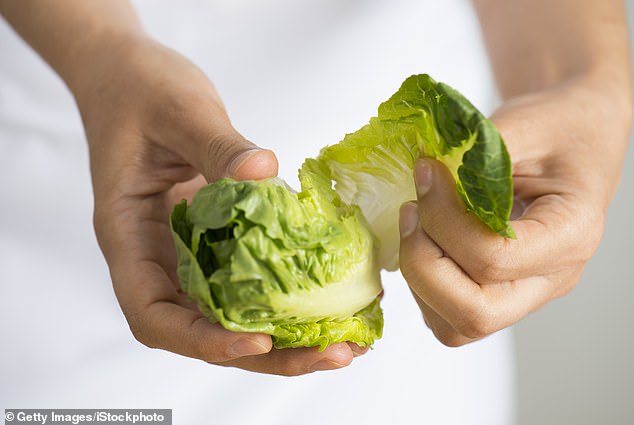
If you don’t have sorrel leaves to hand, you might as well rub lettuce on your nettle stings, scientists claimed last month. While the research left Britons ‘incredulous’, it’s not just the lettuce that has little-known medicinal uses (archive photo)
SALT – COLD
It usually tastes best with chips or a nice steak, but sea salt could also help reduce the symptoms of the common cold, scientists from the University of Edinburgh claim.
They found that gargling with sea salt dissolved in water shortened the duration of a cold by almost two days and reduced the need for over-the-counter medications.
This simple tonic can boost the antiviral defense of cells, which comes into action when they become infected with the cold virus (usually the rhinovirus).
There is no treatment for the common cold and while it usually does not cause serious symptoms, it does have a major economic impact because it causes people to become ill from work, the researchers said.
BEER – BURNS
The British Red Cross advises pouring cold beer over a burn if cold running water is not available.
Somewhere between 90 and 96 percent of beer is water. As long as the drink is cold, it is a good alternative.
According to experts, when applied to a burn, cold water reduces thermal energy, stabilizes blood vessels and reduces the release of pro-inflammatory chemicals.
“It is a valuable and inexpensive way to minimise complications from burns,” said Bronwyn Griffin, a professor at Griffith University’s School of Nursing in Australia.
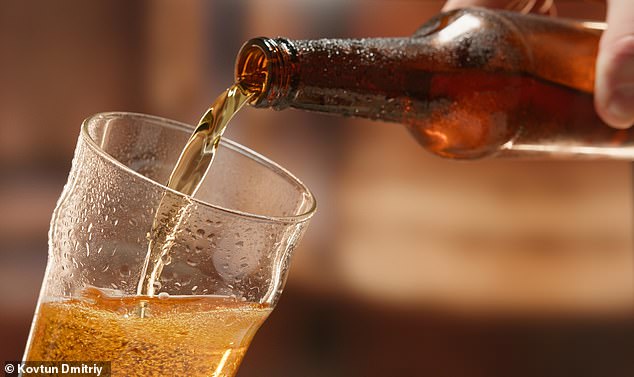
Somewhere between 90 and 96 percent of beer is water, so as long as the drink is cold, it should be a good substitute for water when treating burns (file photo)
MILK – WOUNDS, BURNS
A study published last year by University College London found that milk applied to the skin can help treat wounds.
Laboratory tests have shown that dressings containing casein, a protein naturally found in milk, significantly improved wound healing.
They believe that casein, which is found mainly in cow’s milk, has antimicrobial properties, meaning that it kills microbes that cause infections and diseases.
The British Red Cross also advises using milk to treat burns, along with soft drinks and beer – as long as they are cold.
However, ice is not considered a good treatment for burns because it can cause damage to skin tissue and increase the risk of infection.

The first step in treating burns is to rinse the affected area under cold water. Make sure to remove any clothing or jewelry near the burned skin area (archive photo)
HONEY – WOUNDS
It may sound like vague advice from a bogus home-use manual, but there is now credible scientific evidence for the use of honey in treating wounds.
According to scientists from the University of Manchester, honey has ‘exceptional antimicrobial and tissue regenerative properties’ when physically applied to wounds thanks to certain components.
Its stickiness also forms an effective barrier between the wound site and the external environment, they reported in 2022.
The NHS also agrees that ‘medical honey’ – which is organic and sterilised with radiation to remove dangerous microorganisms – can treat wounds.
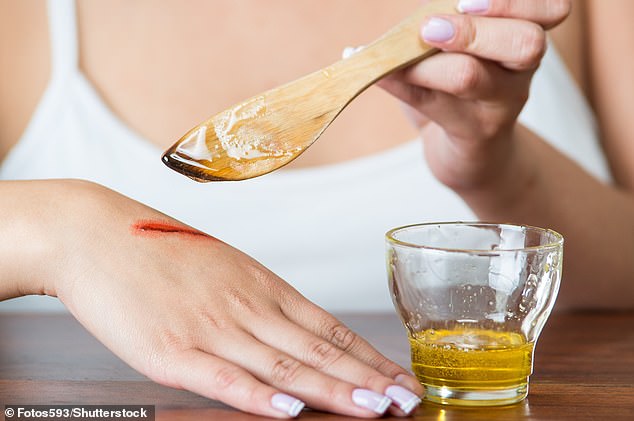
Top tip: Honey is effective in treating local wound bed infections or reducing elevated bacteria levels, says the NHS
But the cheaper table honey you can buy in the supermarket and spread on your toast may not work as well, the NHS warns.
Medical honey has antimicrobial properties and could be ‘an effective alternative to silver-based dressings’ for infected burns, Study 2024 also found.
PEAS – CAPITAL LETTERS
It’s a classic freezer staple in the kitchen, but a bag of frozen peas – or really any small mixed vegetable that’s frozen – can treat a minor head injury
The British Red Cross and the NHS advise holding a bag of frozen peas wrapped in a tea towel to the head to help reduce swelling.
The cold constricts blood vessels and reduces circulation to the affected area. However, a more serious head injury requires immediate medical attention.
People should always call an ambulance if a blow to the head causes vomiting, bleeding, confusion, memory loss, or loss of consciousness.
LETTUCE – NETTLE STING
Research published last month in Journal for emergency care claimed that sweet lettuce leaves were equally effective in reducing the discomfort of nettle stings.
In one study, two-thirds of participants could not tell the difference between a treatment with a sorrel leaf and a treatment with a small amount of lettuce.
But whether you use sorrel leaves or lettuce to treat stings, it’s likely that the placebo effect is at least partly responsible for making you feel better, they suggested.
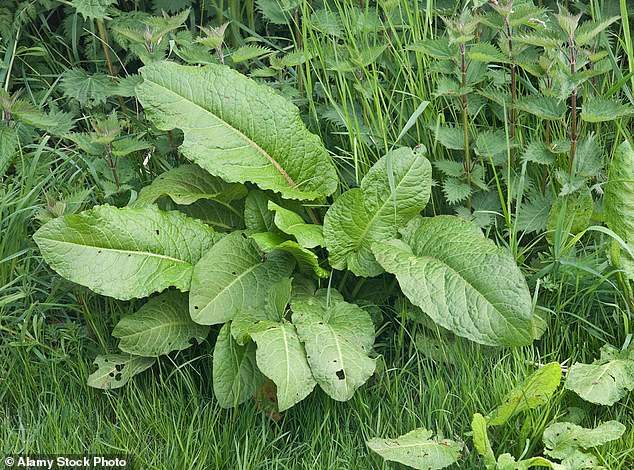
Researchers treated participants’ nettle stings with either a sorrel leaf or a sweet lettuce leaf. Two-thirds of participants could not tell the difference between the two treatments (archive photo)
Study author Rajendra Raman, an emergency medicine specialist at Victoria Hospital in Kirkcaldy, added that many foliage plants could also act as sorrel.
‘I’ve heard that plantain is as good or better for nettle bites than sorrel, and like sorrel it grows in similar habitats to nettles,’ he told MailOnline.
‘However, I would strongly warn people not to pick and rub any plant if they are not sure of its name, as some plants found in the British countryside are downright poisonous.’
BAKING SODA – BEE STINGS
According to Johns Hopkins Medicine in Baltimore, baking soda can reduce the pain and itching that occur with a bee sting.
After washing the affected area with soap and water, they recommend applying a paste of baking soda and water and leaving it on for 15 to 20 minutes.
It is thought that alkaline baking soda can neutralize the acidic toxins released by a bee sting that cause pain.
According to the University of York’s chemistry department, wasp stings are basic and require an acidic solution, such as vinegar.
HOUSEHOLD FOIL – BURNS
If you burn yourself in the kitchen, health experts advise immediately cooling the burn with cold water and calling emergency services.
But once this has happened, cling film can make a useful covering for the affected area, as it forms a barrier that keeps infection at bay.
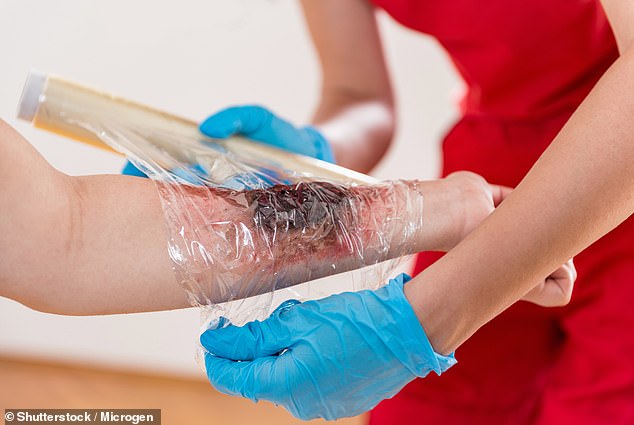
Cling film or plastic will not stick to the burn and reduces pain by keeping air away from the skin’s surface (archive photo)
The cling film should be applied loosely over the burn, rather than wrapped tightly around the wound as you would with a chicken thigh or half an avocado.
a Study from 2015 said that cling film does indeed play a ‘supporting role’ in the treatment of burns, but not in the immediate phase of emergency burn care.
In other words, cool the burn with cold water first and call for medical help. if the burn is serious.
TEA TOWEL – BLEEDING
Most kitchen cuts can be treated with a plaster and will heal within a few days. In more serious cases, where there is heavy bleeding, a tea towel may help.
As long as the tea towel is clean, it can be placed tightly over the wound to stop or slow the blood flow, ultimately preventing blood loss.
According to the British Red Cross, the pressure you apply also causes the blood to clot and the bleeding to stop.
